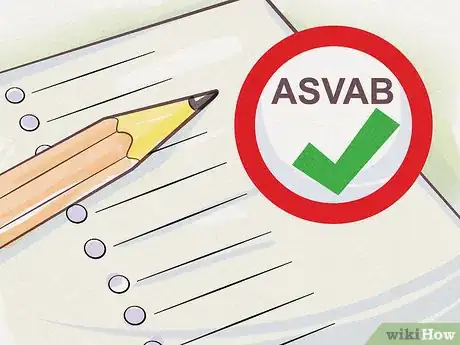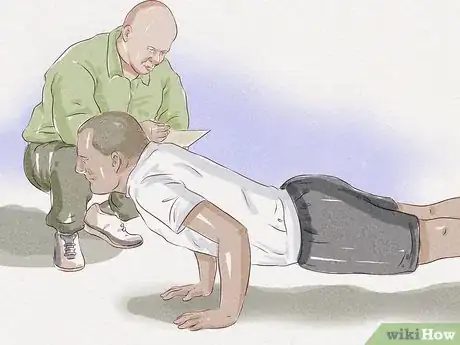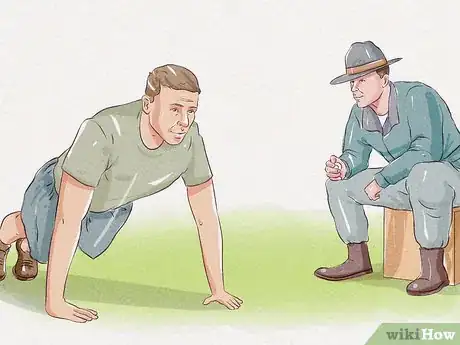This article was co-authored by wikiHow staff writer, Sophia Latorre. Sophia Latorre is a Content Manager on the wikiHow team. Before joining wikiHow, Sophia worked as a technical editor and was published in six International Energy Agency (IEA) Wind Annual Reports. Now, she writes, edits, and reviews articles for the wikiHow Content Team, working to make the content as helpful as possible for readers worldwide. Sophia holds a BA in English from Colorado State University.
This article has been viewed 47,475 times.
Learn more...
Joining the Army Reserves has many benefits, including being able to live anywhere you want while still serving your country. You can also attend school or pursue a career while in the Army Reserves, and will receive education, medical, and retirement benefits. If you are interested in receiving military training and benefits while living a primarily civilian lifestyle, the Army Reserves may be perfect for you!
Steps
Qualifying for Enlistment
-
1Confirm you are a US citizen or resident alien with a high school diploma. To join the Army Reserves, you must be a U.S. citizen or a resident alien. You’ll need to provide documentation of your citizenship, such as a birth certificate or green card. You must also provide proof of a high school diploma. While some candidates with a GED may be accepted, not having a high school diploma will affect your placement within the Army Reserves.
-
2Make sure you are aged 17 to 35 and in good physical health. Applicants that wish to join the Army Reserves must be between the ages of 17 and 35, and 17-year-olds must have parental consent. Applicants must be healthy, in good physical condition, and able to pass a comprehensive physical exam. You must also be in good moral standing, and a criminal record may disqualify you from joining the Army Reserves.Advertisement
-
3Apply online or in person. You will need to submit an application to join the Army Reserves, which you can do online or at a recruiting center. To find an Army Reserves recruiting center in your area, visit https://www.goarmy.com/locate-a-recruiter.html. To create an account and apply online, go to https://www.goarmy.com/learn/apply.html.
- Once you complete the application, a recruiter will contact you and let you know how to move forward with your enlistment, including scheduling your ASVAB test and physical exam.
-
4Prepare for the ASVAB test. The Armed Services Vocational Aptitude Battery, or ASVAB, is a multi-aptitude test that will be administered to you before being accepted into the Army Reserves. Once you have applied to enlist in the Army Reserves, a recruiter will schedule the ASVAB test for you. You should study and prepare for the test, such as by taking ASVAB practice tests online, like at http://www.asvabpracticetests.com/ and http://asvabtutor.com/asvab-practice-tests/.[1]
-
5Obtain a score of 31 or higher on the ASVAB test. There are 4 areas of the ASVAB that determine whether or not you’re eligible to serve in the Army Reserves, including arithmetic reasoning, mathematics knowledge, word knowledge, and paragraph comprehension. The other areas of the exam, including general science, electronics information, auto and shop information, mechanical comprehension, and assembling objects, will determine your placement within the Army Reserves. You will receive your score within 2 weeks of taking the test.[2]
- If you do not pass the ASVAB test with a score of 31 or higher, you must wait 1 calendar month before retaking the test.
-
6Pass a physical exam. After passing the ASVAB with a score of 31 or higher, you’ll also need to pass a complete physical exam administered by a military physician. The exam will include height and weight measurements along with hearing, vision, urine, blood, drug, alcohol, muscle, and joint tests. All these things will be examined to determine if you are in good enough health to join the Army Reserves.
Enlisting and Training
-
1Enlist for 3 to 6 years as a member of the Army Reserves. When you enlist in the Army Reserves, you’ll have a choice between several service options ranging from 3 to 6 years. You’ll have 12 drill weekends and one 2-week training period per year, except in the rare case that you are called for active duty.[3]
- If you aren’t sure if you want to make a long commitment, you can always choose the shortest option and reenlist later.
-
2Attend basic combat training. If you meet all the requirements and pass the ASVAB and physical exams, you will be sent to training. Basic combat training (BCT) is a 10-week course in which you’ll learn basic tactical and survival skills and how to march, rappel, and operate a firearm.[4]
-
3Go to advanced individual training. After BCT, you’ll be sent to a military school in the U.S. to receive advanced individual training (AIT). During your AIT, you’ll gain hands-on experience in the specific career field assigned to you. The length of AIT varies per person and can range from 14-20 weeks.[5]
Serving in the Army Reserves
-
1Lead a civilian life during active duty. After completing BCT and AIT, you can live, go to school, and work wherever you choose within the United States. As a member of the military, you’ll qualify for education funding opportunities as well. Speak to your commanding officer to learn more.[6]
-
2Plan to attend 1 drill per month. As a member of the Army Reserves, you’ll be expected to attend drill one weekend (2 days) each month. During drill, you’ll train with other Army Reserve soldiers, usually at the closest military base to your home location. You will be compensated for your time and your meals will be provided.[7]
- Drill activities vary widely, from practicing formations and completing online training to taking physical training tests or cleaning and operating firearms.
-
3Expect to travel for a 2-week training period each year. In addition to monthly drills, you will have one 2-week training period each year. It’s likely that you’ll travel to another location in the U.S. to train with other Army Reserve soldiers. You’ll be compensated for your time during this training and your travel, lodgings, and meals will be provided for you.[8]
- Compensation varies by rank, but a Private can expect to earn between $3,000 to $4,000 per year as a member of the Army Reserves.
-
4Be ready to be called for active duty. Army Reserve members may be called for active duty at any point in time, likely in the case of crisis or war. Your rank and expertise may determine if or when you are called for active duty. In the event that you are called for active duty, you will be informed by your commanding officer and will be expected to follow all orders regarding shipping out.[9]
-
5Reenlist or opt out at the end of your enlistment period. After 3-6 years, depending on the period of time you enlisted for, you have your choice of what to do next. You can reenlist for another 3-6 years, or opt out of the Army Reserves.[10]
Community Q&A
-
QuestionCan I still join the Army Reserves if I'm already enrolled in college?
 Benjamin ProwellCommunity AnswerYes, you can. It's also possible to look into an ROTC program that might help you with scholarships and give you a boost in rank when you actually join. Contact an ROTC office near you for more information.
Benjamin ProwellCommunity AnswerYes, you can. It's also possible to look into an ROTC program that might help you with scholarships and give you a boost in rank when you actually join. Contact an ROTC office near you for more information. -
QuestionWhat subjects do I need to take to become a soldier?
 Community AnswerThere are no specific subjects you need to take to become a soldier; all aspects of school are utilized. Math, science, and technology courses are always good to have though.
Community AnswerThere are no specific subjects you need to take to become a soldier; all aspects of school are utilized. Math, science, and technology courses are always good to have though. -
QuestionIf I am enrolled in culinary college, can I still go to the army reserve?
 SpaceshipCommunity AnswerYes you can join the army reserve even if you are still in college. To qualify for joining, you have to be between the ages of 18-35, have a clean criminal record, be physically fit, and having no disqualifying medical conditions. When you finish basic training, you can continue your studies while serving in the army reserve.
SpaceshipCommunity AnswerYes you can join the army reserve even if you are still in college. To qualify for joining, you have to be between the ages of 18-35, have a clean criminal record, be physically fit, and having no disqualifying medical conditions. When you finish basic training, you can continue your studies while serving in the army reserve.
References
- ↑ http://official-asvab.com/whattoexpect_app.htm
- ↑ http://official-asvab.com/whattoexpect_app.htm
- ↑ https://todaysmilitary.com/joining/army-reserve
- ↑ https://www.goarmy.com/soldier-life/becoming-a-soldier/basic-combat-training.html
- ↑ https://www.goarmy.com/soldier-life/becoming-a-soldier/advanced-individual-training.html
- ↑ https://www.goarmy.com/about/serving-in-the-army/serve-your-way/army-reserve.html
- ↑ https://www.goarmy.com/about/serving-in-the-army/serve-your-way/army-reserve.html
- ↑ https://www.goarmy.com/about/serving-in-the-army/serve-your-way/army-reserve.html
- ↑ https://www.goarmy.com/about/serving-in-the-army/serve-your-way/army-reserve.html
About This Article
If you want to join the Army Reserves, you’ll first need to make sure you qualify. You need to be a US citizen or resident alien aged between 17 and 35 with a high school diploma to be eligible. If you meet these requirements, fill out an application form online or visit a recruitment center to apply. You’ll also need to pass an ASVAB test, which is a multi-aptitude test. Afterwards, you'll have to complete a physical exam conducted by a military physician. Once you’ve completed the tests, you can choose to enlist for between 3 and 6 years. Usually, you’ll have 12 drill weekends and a 2-week training program each year. To get started, you’ll be sent on a 10-week basic combat training course. For tips on how to prepare to be called for active duty, keep reading!



































































